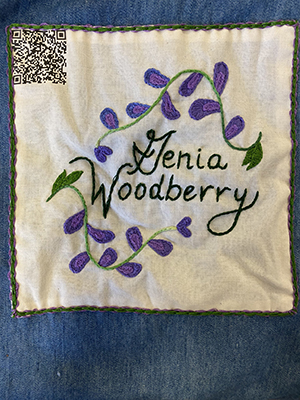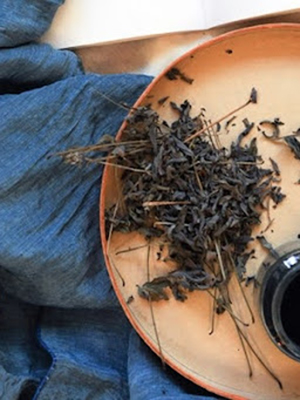Genia Woodberry
"I nursed all Miss Susan’s first children. Slept right there with those children. I was sure born right down yonder to Master Ben Gause’s Plantation. Gade Caesar and Mary Gause were my parents. Then there was Patience who worked to the loom house. She helped do all the weaving for the plantation, weaving all through the winter and all through the summer. She made all kinds of pretty streak in the cloth out of the yarn that they dyed right there on the plantation with things that they got out of the woods like walnut what make brown, and cedar and sweetgum what make purple. Then they make the blue cloth out of that thing that they raise right there on the plantation called indigo. There’s some of that indigo that does grow up there on the Sand Hills to this day and time.” – Genia Woodbury
 A.J. Pesaro ’24
A.J. Pesaro ’24
Indigo has been cultivated for over 6,000 years. Archaeologists have discovered the most ancient examples of indigo dyed cloth in Peru, home of the oldest human settlement in the Americas. The Egyptians in 4400 BCE used an African indigo to dye their clothes, the ancient Chinese of the Xia Dynasty harvested an Asian variant of indigo,and Arab merchants used Indian indigo as a luxury trading good in classical Greece and Rome. Aztecs and other Native American people have used indigo as a medicinal plant, as it effectively stopped bleeding in wounds and acted as an astringent.
When Spanish Conquistadors arrived, they implemented large-scale indigo production in an attempt to displace Portugal’s monopoly on indigo importation from the East. They established vast indigo plantations in Guatemala, Venezuela, and Mexico. By the 1700’s, the English and French colonies of Jamaica and Haiti did the same, increasing the colonizers’ wealth using the enslaved labor and knowledge of African and Indigenous people. Soon, the profits from indigo topped sugar and cotton crops.

By the time of the American Revolution, the dollar had no value and dried indigo cakes were used as currency. On the African continent, one length of indigo cloth could be traded for one human body. After the British lost the American colonies, they turned to India for indigo cultivation. By the late 1800’s the entire market crashed due to the discovery of synthetic dyes, which have been used ever since.
Producing, using, and disposing of synthetic dyes has toxic side effects to our planet. Luckily, in 2022, the world’s leading denim brand, Levi Strauss & Co., invested $4 million in Stony Creek Colors, a women-owned regenerative agriculture firm that sustainably grows indigo in North Carolina. Since indigo is a legume, it can fix nitrogen in the soil, improving soil quality wherever it is planted as a rotation crop. With partnerships such as Levi’s and Stony Creek Colors, some indigo cultivation can now be seen as a carbon neutral offset to the global pollution of the chemical dye industry instead of a prime example of colonial exploitation.
Sources
- Federal Writers' Project: Slave Narrative Project, Vol. 14, South Carolina, Part 4, Raines-Young. 1936.
- Plant of the Month: Indigo - JSTOR Daily
- Stony Creek Colors